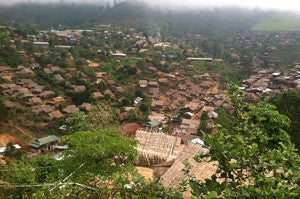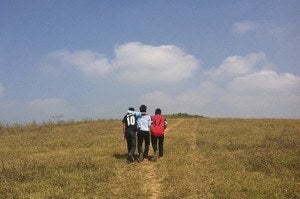May 20, 2014 — The Umpiem Mai refugee camp in western Thailand was erected three decades ago to provide temporary housing for Burmese refugees fleeing the repressive rule of their country’s military government. Today, more than 13,000 people still live in this well-organized community of straw and bamboo buildings packed tightly together on a steep and verdant hillside.
This past winter, eight students from Harvard School of Public Health (HSPH) traveled to the camp to take a course with refugee students at Umpiem Mai’s Public Health Institute (PHI). The course was offered by the Humanitarian Academy at Harvard through the Department of Global Health and Population at HSPH. PHI, started by Community Partners International, a non-governmental organization (NGO), in collaboration with the Karen Department of Health and Welfare (KDHW), provides students from the camp with undergraduate-level general studies, some clinical work, and a year of focused training in public health. The aim is to bolster the local public health workforce to meet the many needs of displaced populations along the Thai-Burma border, such as reproductive health services and infectious disease control.
“Throughout Eastern Burma, there is a real lack of infrastructure, particularly for ethnic minorities,” said Parveen Parmar, who designed and led the course. Parmar is associate director of the Brigham and Women’s Hospital International Emergency Medicine Fellowship and an associate faculty member at Harvard Humanitarian Initiative. “Many of the students at PHI literally fled across the border so that they could find opportunities for higher education,” she said.
Collaborations at the camp
This year’s class of 21 PHI students spent three weeks studying public health research methods alongside the HSPH students at daily lectures taught by Parmar. The HSPH students traveled to the camp each morning in the back of a truck after spending the night at a nearby facility owned by the American Refugee Committee.

“In the camp, there were weird oscillations between things that were exciting and new, and things that would bring home the reality of how hard life is there,” said Corey Peak, SM ’14. “You’d see beautiful kids being kids, playing games that you recognize, next to people scraping by. The emotional highs and lows were very close. It was hard, but I learned so much.”
Each HSPH student was teamed with two or three PHI students for small group discussions and the final project. They met with NGOs and community based organizations (CBOs) providing public health services in the camp, and each team developed a health assessment project designed to support ongoing work of NGOS and CBOs active in camp, or to help them develop new programs.
Projects ran the gamut from understanding women’s attitudes towards early marriage to documenting household rubbish management. Several projects addressed the repercussions of ration cuts, which were imposed last year due to funding reductions.
Kelsey Gleason, SM ’14, and her team investigated the impact of a cut to charcoal rations on household cooking practices. Residents were asked about their fuel choices and if they needed to supplement their rations. One of the team’s findings was that charcoal laid vertically lasted longer than charcoal laid horizontally, a tip that was passed on to the community.

The team coordinated by Peak looked at the availability of soap, water, hand sanitizer, and educational posters on hand washing in public toilets around the camp. An NGO was distributing soap to these locations, which include clinics and schools, but the program was cut in the fall. The PHI students on this team collected data on each of the facilities, which Peak then used to create a map identifying certain types of locations where soap and water was more available. The team worked with camp leadership to find what lessons could be learned from locations with good coverage, and how they could be applied to locations with lower coverage.
Staying connected

During the second part of the course, held in the first half of the spring semester, the student teams worked together remotely to complete the projects. PHI students conducted household surveys and other data-gathering activities, communicating over Skype with their HSPH colleagues who provided the analysis. The students also continued meeting each week for joint lectures, which were delivered via video conferencing.
Data gathered by all the student teams was presented in person to each partner NGO or CBO by the PHI students, and a summary of the results was shared over Skype with representatives from the American Refugee Committee.
Despite the frustrations inherent in working remotely around a language barrier and 12-hour time difference, “there was never any fear that the work wouldn’t get done,” Gleason said.
For students hoping to work in humanitarian crisis settings, getting a foot in the door can be very difficult, Peak said. “Now I can say that I have experience in a refugee camp and have worked with a team to develop a study and implement it. Getting the opportunity to do this as a student was huge.”
Photo: Emily Cuccarese
